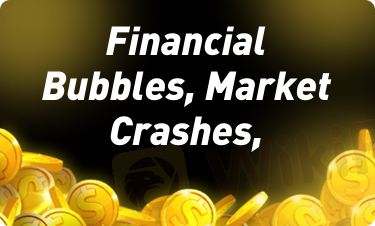
2025-02-17 18:19
NgànhFinancial Market Bubbles and Crashes
#firstdealofthenewyearastylz
Financial Market Bubbles and Crashes
A financial market bubble occurs when asset prices rise significantly above their intrinsic value due to excessive speculation, investor overconfidence, and herd behavior. Eventually, when the overvaluation is no longer sustainable, the bubble bursts, leading to a market crash—a rapid and often severe decline in asset prices.
Causes of Financial Bubbles
1. Excess Liquidity – Low interest rates and easy access to credit can inflate asset prices.
2. Speculation & Herd Mentality – Investors buy assets purely based on rising prices, not fundamentals.
3. Overconfidence & Irrational Exuberance – Investors ignore risks and believe prices will keep rising.
4. Leverage & Margin Trading – Borrowing money to invest amplifies gains but also magnifies losses.
5. Technological or Economic Innovations – New industries (e.g., dot-com boom) attract speculative investments.
Notable Financial Bubbles in History
1. Tulip Mania (1630s, Netherlands) – Tulip bulbs were traded at absurd prices before crashing.
2. South Sea Bubble (1720, UK) – Stock prices of the South Sea Company surged due to speculation and collapsed.
3. 1929 Stock Market Crash – Excessive speculation in stocks led to the Great Depression.
4. Dot-Com Bubble (1999-2000) – Internet company stocks soared irrationally before collapsing.
5. 2008 Financial Crisis – A housing bubble fueled by subprime mortgages burst, leading to a global recession.
Market Crashes: Causes & Effects
A market crash is triggered when investor confidence collapses, leading to panic selling. This can result from:
Economic shocks (e.g., financial crises, wars, pandemics)
Policy changes (e.g., interest rate hikes)
Corporate failures (e.g., Lehman Brothers in 2008)
Effects of a Market Crash:
Wealth Destruction – Investors and businesses lose significant value.
Bank Failures – If financial institutions are exposed, they may collapse.
Unemployment – Economic downturns often follow, leading to job losses.
Government Interventions – Bailouts, stimulus packages, and policy changes may be necessary.
Lessons from Market Bubbles & Crashes
Diversification reduces risk.
Avoid speculation and excessive leverage.
Understand fundamental value rather than following hype.
Monitor interest rates and economic indicators.
Be prepared for market corrections; they are inevitable.
Thích 0

Ojomary
Mga brokers
Bình luận phổ biến
Ngành
Có cao quá k?
Ngành
Xin ý kiến liberforex
Ngành
Đầu tư CDG
Ngành
Cắt lỗ
Ngành
Có nên chốt lỗ?
Ngành
Hỏi về dòng tiền
Phân loại diễn đàn

Nền tảng

Triển lãm

IB

Tuyển dụng

EA

Ngành

Chỉ số thị trường

Chỉ số
Financial Market Bubbles and Crashes
 Hong Kong | 2025-02-17 18:19
Hong Kong | 2025-02-17 18:19#firstdealofthenewyearastylz
Financial Market Bubbles and Crashes
A financial market bubble occurs when asset prices rise significantly above their intrinsic value due to excessive speculation, investor overconfidence, and herd behavior. Eventually, when the overvaluation is no longer sustainable, the bubble bursts, leading to a market crash—a rapid and often severe decline in asset prices.
Causes of Financial Bubbles
1. Excess Liquidity – Low interest rates and easy access to credit can inflate asset prices.
2. Speculation & Herd Mentality – Investors buy assets purely based on rising prices, not fundamentals.
3. Overconfidence & Irrational Exuberance – Investors ignore risks and believe prices will keep rising.
4. Leverage & Margin Trading – Borrowing money to invest amplifies gains but also magnifies losses.
5. Technological or Economic Innovations – New industries (e.g., dot-com boom) attract speculative investments.
Notable Financial Bubbles in History
1. Tulip Mania (1630s, Netherlands) – Tulip bulbs were traded at absurd prices before crashing.
2. South Sea Bubble (1720, UK) – Stock prices of the South Sea Company surged due to speculation and collapsed.
3. 1929 Stock Market Crash – Excessive speculation in stocks led to the Great Depression.
4. Dot-Com Bubble (1999-2000) – Internet company stocks soared irrationally before collapsing.
5. 2008 Financial Crisis – A housing bubble fueled by subprime mortgages burst, leading to a global recession.
Market Crashes: Causes & Effects
A market crash is triggered when investor confidence collapses, leading to panic selling. This can result from:
Economic shocks (e.g., financial crises, wars, pandemics)
Policy changes (e.g., interest rate hikes)
Corporate failures (e.g., Lehman Brothers in 2008)
Effects of a Market Crash:
Wealth Destruction – Investors and businesses lose significant value.
Bank Failures – If financial institutions are exposed, they may collapse.
Unemployment – Economic downturns often follow, leading to job losses.
Government Interventions – Bailouts, stimulus packages, and policy changes may be necessary.
Lessons from Market Bubbles & Crashes
Diversification reduces risk.
Avoid speculation and excessive leverage.
Understand fundamental value rather than following hype.
Monitor interest rates and economic indicators.
Be prepared for market corrections; they are inevitable.
Thích 0
Tôi cũng muốn bình luận.
Đặt câu hỏi
0bình luận

Chưa có người bình luận, hãy là người bình luận đầu tiên

Đặt câu hỏi
Chưa có người bình luận, hãy là người bình luận đầu tiên